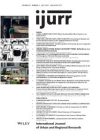Dubai’s ecologic and economic complications are exacerbated by six years of accelerated expansion, a fixed top‐down approach to urbanism and the construction of iconic single‐phase mega‐projects. With recent construction delays, project cancellations and growing landscape issues, Dubai’s tower typologies have been unresponsive to changing environmental, socio‐cultural and economic patterns (BBC, 2009; Gillet, 2009; Lewis, 2009). In this essay, a theory of ‘Big Regionalism’ guides an argument for an economically and ecologically linked tower typology called the Condenser. This phased ‘box‐to‐tower’ typology is part of a greater Landscape Urbanist strategy called Vertical Landscraping. Within this strategy, the Condenser’s role is to densify the city, facilitating the creation of ecologic voids that order the urban region. Delineating ‘Big Regional’ principles, the Condenser provides a time‐based, global–local urban growth approach that weaves Bigness into a series of urban‐regional, economic and ecological relationships, builds upon the environmental performance of the city’s regional architecture and planning, promotes a continuity of Dubai’s urban history, and responds to its landscape issues while condensing development. These speculations permit consideration of the overlooked opportunities embedded within Dubai’s mega‐projects and their long‐term impact on the urban morphology.
Details
Written by:
MATTHEW WILSON
Digital Object Identifier (DOI)
10.1111/j.1468-2427.2010.01007.x
About DOI
Read full article as PDF
Read full article as HTML
See the references for this article
